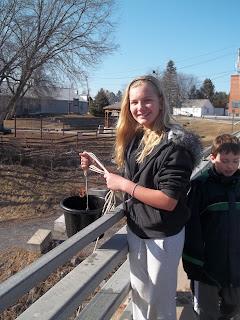A small group meet on Sunday afternoon to work on the Tantalus.
First the group collected water from the Little Ausable River from the Route 22 overpass. They threw a bucket down to the water attached to a 100ft cord and hauled water to fill two 5 gallon buckets. To ensure the bucket would not get pulled away with the current, the end was tied to the railing.
 |
| Emma preparing to drop the bucket over |
 |
| The Water Hauling Team |
 |
| It's a long way down! |
 |
| Bradley waiting for his turn |
After hauling the water back to the fire station and filling the two biosand
filters, they set to work on adding a “Cup” device to the pipe
inside the bucket. A hole needed to be drilled in the plastic cup to
fit the “fitting” through. One of the leaders discovered the
drill bit was in his tool bag BUT not the drill. The fire department
did not have one. (They asked.) Liam put the plastic cup in the fire
department vice and with a pare of adjustable pliers holding the
drill bit, hand drilled the hole.
Liam drilling the hole by hand
Since this was a lengthy process to
get through the plastic, the other members learned to use the
Turbidity meter. First they had to gather samples:
 |
| Filling the sample bottle |
 |
| Putting on the screw cap |
 |
| Filling the testing jar |
With help from the Matt (leader who has used one before) and a
quick cursory read of the directions, we started testing the water.
We opted to use the number 10 solution for the calibration. We tested
the water that was collected from the Little Ausable and it has a
turbidity of 24. The guide said we wanted below 0.3 to drink. We
tested the water coming out of each filter. The Red filter (natural
sand) has a reading of 3.4 and the
Black filter (manufactured sand)
has a reading of 0.31. We were ecstatic! Our filters were definitely
starting to work.
 |
| Reading the turbidity meter results |
By the time the water testing was done, Liam (with a very sore
hand) had the hole drilled. We added it to the inside of the pipe in
the bucket to generate more air pressure so regulate the flow in the
Tantalus better. It helped build more air pressure but there was a constant drip instead of a
shut off.
 |
| Plastic dish with fitting attached |
 |
| A look from the inside |
 |
| Bradley holding the whole assembly |
Then came the 2 hours of watching the Tantalus work and making
minor modifications. We moved the coils, cut cable ties
(intentionally restricting the flow in places as well as holding
loops together), and changed the height of the pipe inside the
bucket. After about 40 minutes of watching, Madeline and Bradley
noticed that the problem seemed to be in the two-coil loop. They
suspected if the coil was just one loop, the Tantalus would operate
effectively. We were waiting for one leader to return with dinner
before we cut the plastic tubing, so the other leader held the
plastic piping in position. (It was too long with only one loop and
kept wanting to recoil.) Matt actually had a short piece of plastic
tubing that Liam bent into a loop and tied with cable ties. It
worked! (Sort of a Eureka moment!) We watched it for about an hour to
make sure it would constantly work.
Grace spent most to the time working on the guidelines for making
the turbidity meter work. We learned you can only calibrate the
system a couple of times and then it won't let you for a while. We
learned that the same sample can give different reading so a
procedure would need to be developed.
Members Present: Bradley N., Liam S., Grace S., Emma S.,
Madeline L., plus two leaders and one parent














No comments:
Post a Comment